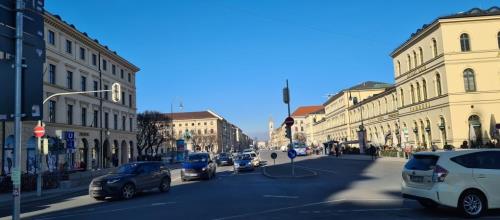Leben in München

Mary Howitt zeigt, dass sie sich mit München auskennt: Die Geschichte beginnt mit einem Festumzug in der Ludwigstraße und einer Ausstellung des Kunst-Vereins am Hofgarten und gleich auf den ersten Seiten werden zudem das Café Tambosi (wie in The Initials), der Englische Garten und die Frühlingstraße erwähnt.
Der Kunst-Verein veranstaltet später auch einen Faschingsball am Odeonsplatz, der als extrem prunkvoll beschrieben wird:
[A]nd now they stood within the theatre itself, the pit converted into a vast ball-room, from the centre of which arose a fairy pavilion of golden gothic tracery, festooned with living wreaths of the most lovely exotic creepers, with golden dolphins spouting forth streams of ruddy wine into a golden fountain beneath the golden pavilion: with the richly emblazoned banners of the different artist-corps, floating in gorgeous folds and streamers from above it, with the spaces between the boxes draped with the same corps colours, binding together artistic trophies of palettes and brushes, alternating with groups of musical instruments: and the whole vast space was one moving mass of brilliant colour, whilst the walls were peopled with quaint and gorgeous crowds gazing down upon the quaint and gorgeous crowds below, and over all, and through all, sounded gay laughter, and shrill cries, and a maddening hum of frantic merriment.
(Margaret von Ehrenberg, the Artist-Wife, S. 53)
So wie The Initials eine mysteriöse Figur ‚verkleidet‘ als „Türke“ (A. Z. Aus dem Münchner Leben, Bd. IV, S. 115) beinhaltet, so beschreibt Anna Mary Howitt eine Person ‚verkleidet‘ als „Bedouin“ (An Art-Student in Munich, Bd. II, S. 186) und Mary Howitt einen Mann ‚verkleidet‘ als „Indian“ (Margaret von Ehrenberg, the Artist-Wife, S. 58). Neben typischen Bräuchen werden – wie in Tautphoeus‘ Romanen – auch hier immer wieder deutsche Wörter eingebaut, wie Straßennamen, Einrichtungen, Flüche und Konzepte wie „Leib- oder Mehlspeise“, die teilweise erklärt/übersetzt werden und teilweise aus dem Kontext erschlossen werden müssen.
Weitere Kapitel:

Mary Howitt zeigt, dass sie sich mit München auskennt: Die Geschichte beginnt mit einem Festumzug in der Ludwigstraße und einer Ausstellung des Kunst-Vereins am Hofgarten und gleich auf den ersten Seiten werden zudem das Café Tambosi (wie in The Initials), der Englische Garten und die Frühlingstraße erwähnt.
Der Kunst-Verein veranstaltet später auch einen Faschingsball am Odeonsplatz, der als extrem prunkvoll beschrieben wird:
[A]nd now they stood within the theatre itself, the pit converted into a vast ball-room, from the centre of which arose a fairy pavilion of golden gothic tracery, festooned with living wreaths of the most lovely exotic creepers, with golden dolphins spouting forth streams of ruddy wine into a golden fountain beneath the golden pavilion: with the richly emblazoned banners of the different artist-corps, floating in gorgeous folds and streamers from above it, with the spaces between the boxes draped with the same corps colours, binding together artistic trophies of palettes and brushes, alternating with groups of musical instruments: and the whole vast space was one moving mass of brilliant colour, whilst the walls were peopled with quaint and gorgeous crowds gazing down upon the quaint and gorgeous crowds below, and over all, and through all, sounded gay laughter, and shrill cries, and a maddening hum of frantic merriment.
(Margaret von Ehrenberg, the Artist-Wife, S. 53)
So wie The Initials eine mysteriöse Figur ‚verkleidet‘ als „Türke“ (A. Z. Aus dem Münchner Leben, Bd. IV, S. 115) beinhaltet, so beschreibt Anna Mary Howitt eine Person ‚verkleidet‘ als „Bedouin“ (An Art-Student in Munich, Bd. II, S. 186) und Mary Howitt einen Mann ‚verkleidet‘ als „Indian“ (Margaret von Ehrenberg, the Artist-Wife, S. 58). Neben typischen Bräuchen werden – wie in Tautphoeus‘ Romanen – auch hier immer wieder deutsche Wörter eingebaut, wie Straßennamen, Einrichtungen, Flüche und Konzepte wie „Leib- oder Mehlspeise“, die teilweise erklärt/übersetzt werden und teilweise aus dem Kontext erschlossen werden müssen.
